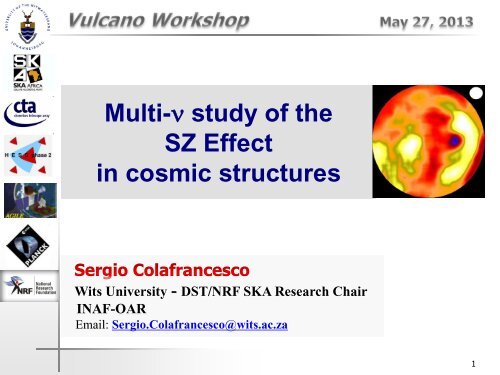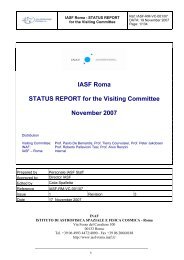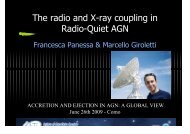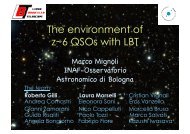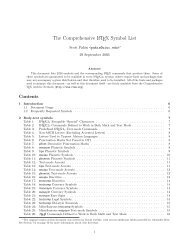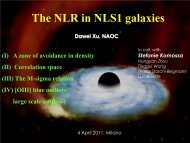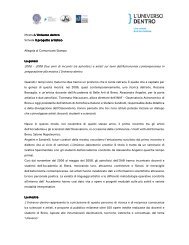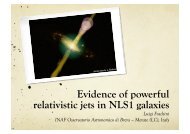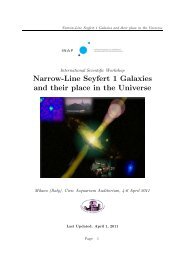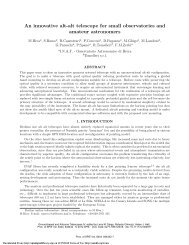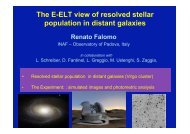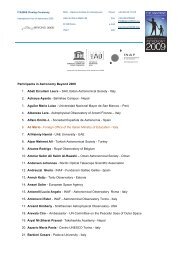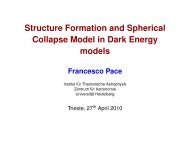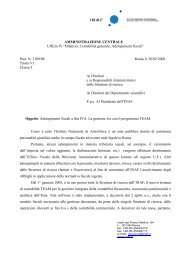17.25 Sergio COLAFRANCESCO Multifrequency Study of the SZ ...
17.25 Sergio COLAFRANCESCO Multifrequency Study of the SZ ...
17.25 Sergio COLAFRANCESCO Multifrequency Study of the SZ ...
You also want an ePaper? Increase the reach of your titles
YUMPU automatically turns print PDFs into web optimized ePapers that Google loves.
Multi-n study <strong>of</strong> <strong>the</strong><br />
<strong>SZ</strong> Effect<br />
in cosmic structures<br />
Wits University - DST/NRF SKA Research Chair<br />
INAF-OAR<br />
Email: <strong>Sergio</strong>.Colafrancesco@wits.ac.za<br />
1
LSS @ Multi-frequency
A Galaxy Cluster<br />
Perseus Cluster<br />
X-ray: NASA/CXC/IoA/A.Fabian et al.<br />
Radio: NRAO/VLA/G. Taylor<br />
Optical: NASA/ESA/Hubble Heritage (STScI/AURA) & Univ. <strong>of</strong> Cambridge/IoA/A. Fabian
A Galaxy Cluster<br />
Radio<br />
Radio<br />
X-ray<br />
Gamma-ray<br />
Optical<br />
Th. Bremsstrahlung<br />
p 0 decay<br />
X-ray<br />
Synchrotron<br />
ICS<br />
Bremsstrahlung<br />
g-rays<br />
TeV<br />
Galaxy clusters show various non-<strong>the</strong>rmal phenomena<br />
related to <strong>the</strong> presence <strong>of</strong> Thermal plasma, Cosmic Rays, B-<br />
fields, BHs, Dark Matter, Galaxies, Active Galaxies, …<br />
that are not yet fully understood. (see, e.g.,<br />
4
A Galaxy Cluster<br />
Radio<br />
Perseus cluster<br />
X-rays<br />
Radio Halo<br />
NGC1275<br />
Blazar core<br />
n-plasmoids<br />
Optical<br />
X-ray<br />
[Colafrancesco et al. 2010]]<br />
g-rays<br />
TeV<br />
Multi-n emission <strong>of</strong> Galaxy Clusters is <strong>of</strong>ten over-shined by<br />
<strong>the</strong> emission <strong>of</strong> <strong>the</strong> central Radio Galaxy<br />
(see, e.g., Perseus/NGC1275)<br />
5
Clusters: crossroads <strong>of</strong> cosmic physics<br />
Dark Matter<br />
Cosmic rays<br />
AGNs<br />
B field<br />
Thermal plasma
Strategy<br />
Multi-D tomography<br />
(disentangle cluster atmospheres)<br />
Multi-technique<br />
single-purpouse<br />
(Radio to TeV)<br />
Multi telescopes<br />
Multi techniques<br />
Single-technique<br />
multi-purpouse<br />
(mm)<br />
Single telescope<br />
Single technique<br />
radio mwave-mm X-ray g-ray TeV mwave-mm
What is <strong>the</strong> <strong>SZ</strong>E Physics<br />
Photon fields<br />
Internal<br />
↓<br />
External<br />
↓<br />
Use CMB photons<br />
to extract<br />
plasma information<br />
↑<br />
Internal<br />
High-E electrons<br />
- <strong>the</strong>rmal (supra-<strong>the</strong>rmal)<br />
- relativistic<br />
high-energy<br />
photon
Why <strong>the</strong> <strong>SZ</strong>E General derivation<br />
<strong>SZ</strong>E yields a measure <strong>of</strong> <strong>the</strong> total pressure in cluster atmospheres<br />
I 0 (x)<br />
Thermal<br />
I(x)<br />
Relativistic<br />
I rel (x)<br />
<strong>the</strong>rmal NR e -<br />
n<br />
kT<br />
4<br />
n m c<br />
e<br />
2<br />
e<br />
n 4<br />
relativistic e - g<br />
2<br />
n 3
<strong>SZ</strong>E-kinematic: general derivation<br />
Intensity change<br />
Momentum<br />
T<br />
T<br />
0<br />
p<br />
e<br />
kin<br />
g <br />
h(<br />
x)<br />
<br />
m v<br />
e<br />
1<br />
m c<br />
e<br />
<br />
pe<br />
d Tne<br />
p<br />
p<br />
h(<br />
x)<br />
<br />
m c<br />
Relativistic generalization<br />
e<br />
Spectral shape<br />
4 x<br />
x e<br />
h( x)<br />
<br />
2<br />
1<br />
( x ) <br />
x<br />
rel<br />
e 1<br />
CMB spectrum
<strong>SZ</strong>E: polarization<br />
Polarizations arises as<br />
a natural outcome <strong>of</strong><br />
g-e ± scattering<br />
→ various <strong>SZ</strong>E polarizations<br />
Polarization due to peculiar<br />
motion <strong>of</strong> clusters<br />
t<br />
<br />
2 <br />
t<br />
V<br />
Polarization due to transverse<br />
motions <strong>of</strong> plasma within<br />
<strong>the</strong> cluster<br />
2<br />
V<br />
t<br />
<br />
Polarization due to<br />
multiple scattering g-e ±<br />
within <strong>the</strong> cluster<br />
<br />
T<br />
<br />
<br />
<br />
<br />
kT<br />
m c<br />
e<br />
<br />
<br />
<br />
2<br />
2
How is <strong>the</strong> <strong>SZ</strong>E Spectro-polarimetry<br />
<strong>SZ</strong>E Intensity<br />
sensitivity to projected<br />
physical parameters<br />
<strong>SZ</strong> kin<br />
<strong>SZ</strong> th<br />
<strong>SZ</strong> warm<br />
, kT e , P e , E e , M c , V t<br />
<strong>SZ</strong> DM<br />
<strong>SZ</strong> rel<br />
<strong>SZ</strong>E polarization<br />
sensitivity to 3-D distribution <strong>of</strong><br />
physical parameters<br />
For a <strong>the</strong>rmal plasma:<br />
• Velocity sub-structure (≈ 2 )<br />
• Temp. sub-structure (≈T e 2 )<br />
5 keV<br />
20 keV
Astrophysics & Cosmology<br />
The <strong>SZ</strong>E is independent <strong>of</strong> redshift<br />
and <strong>the</strong>refore it is an optimal tool<br />
for Cosmological applications<br />
Standard-rod “physical” effect<br />
X-rays<br />
X-rays<br />
X-rays<br />
The <strong>SZ</strong>E depends directly on <strong>the</strong><br />
electron distribution in <strong>the</strong> atmospheres<br />
<strong>of</strong> cosmic structures and <strong>the</strong>refore it is an<br />
optimal tool for Astrophysical applications<br />
Cosmic Lepto-meter, Speed-meter
Simple <strong>SZ</strong>E AstroPhysics<br />
Shape<br />
Spectrum<br />
Contamination<br />
First <strong>SZ</strong>E spectrum Coma<br />
cluster (MITO exp.)<br />
(DePetris et al. 2002)<br />
30GHz<br />
90GHz<br />
OVRO (30 GHz)<br />
<strong>SZ</strong>E has larger angular<br />
size than X-ray image<br />
L X ~ n 2 (r) T 1/2<br />
Y <strong>SZ</strong> ~ n(r) T<br />
• Spectrum observed in a few<br />
bands (30, 150, 220, 275 GHz)<br />
• The zero near <strong>the</strong> peak <strong>of</strong><br />
CMB spectrum (~ 220 GHz)<br />
RXJ1347-1145.
MACS J07017.5+3745<br />
A Triple-Merger<br />
Cluster <br />
B) kT = 12.8 kev (+2.1/-1.6)<br />
V = 3600 km/s (+3440/-2160)<br />
V = 3238 km/s (252/-242)<br />
C) kT = 34.0 kev (+11/-7.9)<br />
V = -3720 km/s (+2960/-2480)<br />
V = -733 k/s (+486/-478)<br />
D) kT ≈ 4 keV<br />
V = 831 km/s (843/-700)<br />
A) kT ≈ 2 keV<br />
V = 278 km/s (+295/-339)<br />
[Mroczkowski et al. 2011]
MACS J07017.5+3745<br />
A Triple-Merger<br />
Cluster <br />
B) kT = 12.8 kev (+2.1/-1.6)<br />
V = 3600 km/s (+3440/-2160)<br />
V = 3238 km/s (252/-242)<br />
C) kT = 34.0 kev (+11/-7.9)<br />
V = -3720 km/s (+2960/-2480)<br />
V = -733 k/s (+486/-478)<br />
D) kT ≈ 4 keV<br />
V = 831 km/s (843/-700)<br />
A) kT ≈ 2 keV<br />
V = 278 km/s (+295/-339)
MACS J07017.5+3745<br />
A Triple-Merger<br />
Cluster <br />
B) kT = 12.8 kev (+2.1/-1.6)<br />
V = 3600 km/s (+3440/-2160)<br />
V = 3238 km/s (252/-242)<br />
C) kT = 34.0 kev (+11/-7.9)<br />
V = -3720 km/s (+2960/-2480)<br />
V = -733 k/s (+486/-478)<br />
D) kT ≈ 4 keV<br />
V = 831 km/s (843/-700)<br />
A) kT ≈ 2 keV<br />
V = 278 km/s (+295/-339)<br />
E) Non-<strong>the</strong>rmal component<br />
s=3.5, p1=0.1<br />
=5 10 -4 – 2 10 -2
MACS J07017.5+3745<br />
Comp. C<br />
[S.C. &<br />
Marchegiani 2013]<br />
Comp. C<br />
Comp. B
The Road to AstroPhysics<br />
Independent<br />
<strong>of</strong> astrophysics<br />
Strongly dependent<br />
on astrophysics<br />
I<br />
y<br />
th<br />
( kT )<br />
( hc)<br />
3<br />
2 0 y g(<br />
x<br />
th 2 th<br />
<br />
kT<br />
e<br />
<br />
T<br />
dne<br />
2<br />
mec<br />
)<br />
Accessible<br />
from Space<br />
Need external priors<br />
• X-ray kT<br />
• GL M<br />
• O z<br />
for a proper use in<br />
• Cosmology<br />
• Astrophysics<br />
OVRO<br />
MUSTANG<br />
SPT<br />
kT= 7 keV<br />
kT=10 keV<br />
kT=15 keV<br />
kT=20 keV
Planck-Herschel Era: multi-n<br />
A2319<br />
THE PLANCK EARLY <strong>SZ</strong> SKY<br />
189 <strong>SZ</strong> sources (S/N > 6)<br />
‣ First <strong>SZ</strong>E measure for<br />
~ 80% <strong>of</strong> known clusters<br />
‣ 37 new clusters<br />
PLANCK <strong>SZ</strong> Source CATALOG<br />
1227 <strong>SZ</strong> sources<br />
‣ 861 confirmed clusters<br />
- 683 known clusters<br />
- 178 new clusters<br />
‣ 366 cluster candidates
P-H Era: <strong>SZ</strong>E spectrum<br />
Abell 2319: LFI-HFI PLANCK <strong>SZ</strong>E spectrum<br />
Stacked <strong>SZ</strong> spectrum<br />
confirmed<br />
candidate<br />
IR and Radio source spectrum
The Planck take on <strong>SZ</strong>E<br />
• Statistics<br />
• X-ray Luminosity<br />
• Optical<br />
• DM Mass<br />
• Massive<br />
• Luminous<br />
• Complex<br />
• Super-clusters<br />
• Intra-cluster Physics<br />
• Intensive quantities (P, kT, …)
DM<br />
P-H Era: towards AstroPhysics<br />
First evidence <strong>of</strong> <strong>SZ</strong>E<br />
relativistic / non-<strong>the</strong>rmal<br />
[Zemcov 250 mm et al. 2010]<br />
Herschel SPIRE<br />
view <strong>of</strong> <strong>the</strong><br />
Bullet cluster<br />
Radio Halo<br />
non-relativistic<br />
350 mm<br />
500 mm<br />
n
<strong>SZ</strong>E: probes <strong>of</strong> AstroPhysics<br />
Multi - Temperature<br />
kT 1 = 13.9 keV =3.5 10 -3<br />
kT 2 = 25 keV, =5.5 10 -3<br />
Thermal + non-<strong>the</strong>rmal<br />
kT = 13.9 keV =1.1 10 -2<br />
n e ~E -2.7 , p 1 =1, =2.4 10 -4<br />
T2<br />
c 2 =1.27<br />
d.o.f.=1<br />
rms fom=1<br />
Thermal<br />
c 2 =0.44<br />
d.o.f.=2<br />
rms fom=0.35<br />
T1<br />
Non-<strong>the</strong>rmal<br />
[S.C. et al. 2011] [S.C. et al. 2011]<br />
Evidence <strong>of</strong> non-gravitational activity in <strong>the</strong> cluster merging<br />
Shock acceleration or MHD acceleration<br />
Stochastic electron acceleration<br />
Continuous hadron acceleration
<strong>SZ</strong>E: 3-d tomography<br />
Morphological <strong>SZ</strong>E<br />
T standard deviation<br />
First measurement <strong>of</strong> <strong>the</strong><br />
Temperature standard deviation<br />
in galaxy clusters: using <strong>the</strong> <strong>SZ</strong>E<br />
[Prokhorov & Colafrancesco 2012]<br />
I<br />
I<br />
345 GHz Laboca 600 GHz Herschel<br />
600GHz<br />
345GHz<br />
A2219<br />
[Prokhorov, S.C. et al. 2011b]<br />
Shock<br />
hot<br />
Bullet<br />
cold<br />
Bullet Cluster<br />
~ 13.9 keV<br />
= 10.6 ± 3.8 keV<br />
• Measure <strong>of</strong> <strong>the</strong> temperature<br />
stratification in clusters<br />
• Measure <strong>of</strong> plasma in-homogeneity<br />
(th.+non-th.) along <strong>the</strong> line-<strong>of</strong>-sight
<strong>SZ</strong>E: Radio Halo clusters<br />
RH vs <strong>the</strong>rmal pressure<br />
RH vs total pressure<br />
Bimodality<br />
- active RHs<br />
- in-active RHs<br />
(Brunetti et al 2009)<br />
(Basu 2012)<br />
No Bimodality<br />
- all RH clusters have Y <strong>SZ</strong>
<strong>SZ</strong>E<br />
Measuring P non-th : Y <strong>SZ</strong> - L X<br />
Self-similar G-only<br />
cluster formation<br />
Y <strong>SZ</strong><br />
≈ L X<br />
5/4<br />
(1+x)<br />
Self-similar cluster formation +<br />
non-<strong>the</strong>rmal pressure evolution<br />
X ≈ L X<br />
-0.81<br />
X-ray<br />
[S.C. et al. 2013]<br />
X=P non-th<br />
/P th<br />
evolution with L X<br />
X ≈ L X<br />
-0.81<br />
[S.C. et al. 2013]
Exploiting <strong>SZ</strong>E information<br />
Different spectroscopic configurations<br />
for studying <strong>the</strong> <strong>SZ</strong>E in cosmic structures<br />
EC2<br />
3m<br />
passive<br />
<strong>SZ</strong> kin<br />
Foreground<br />
EC3<br />
12m<br />
passive<br />
<strong>SZ</strong> th<br />
<strong>SZ</strong> non-th<br />
EC5<br />
12m<br />
active<br />
[DeBernardis, Colafrancesco et al. 2012]
Exploiting <strong>SZ</strong>E information<br />
Different spectroscopic configurations<br />
for studying <strong>the</strong> <strong>SZ</strong>E in cosmic structures<br />
EC2<br />
3m<br />
passive<br />
EC3<br />
12m<br />
passive<br />
SPT<br />
PLANCK<br />
Herschel<br />
EC5<br />
12m<br />
active<br />
[DeBernardis, Colafrancesco et al. 2012]
<strong>SZ</strong>E spectroscopy: <strong>the</strong>rmal plasma<br />
The relativistic kinetic <strong>the</strong>ory<br />
(DF derivation) <strong>of</strong> astrophysical plasma<br />
is still unknown !<br />
Juttner<br />
Maxwell-Boltzmann<br />
Non-relativistic<br />
A method based on Fourier analysis<br />
to derive <strong>the</strong> velocity DF <strong>of</strong> electrons<br />
by using <strong>SZ</strong>E observations at ≥ 4<br />
frequencies.<br />
[Prokhorov, Colafrancesco, et al. 20011a]<br />
<strong>SZ</strong>E spectroscopy will allow to<br />
derive spatially resolved T-pr<strong>of</strong>iles for<br />
nearby clusters out to large radii:<br />
Perseus<br />
Inversion Technique <strong>SZ</strong>E → T, , V p , T CMB<br />
T pr<strong>of</strong>ile with uncertainties similar to<br />
those <strong>of</strong> X-ray observations<br />
T pr<strong>of</strong>ile uniquely sampled in <strong>the</strong> outer<br />
parts <strong>of</strong> <strong>the</strong> cluster<br />
<strong>SZ</strong>E<br />
X-Ray<br />
[Colafrancesco & Marchegiani 2010]
<strong>SZ</strong>E spectro-polarimetry: 3-d<br />
<strong>SZ</strong>E intensity spectrum allow to measure <strong>the</strong> plasma temperature kT<br />
Polarization due to finite optical depth allow to measure <strong>the</strong> density<br />
and velocity distribution <strong>of</strong> <strong>the</strong> electron plasma → 3-d phase-space<br />
I<br />
<br />
T<br />
<br />
71.43<br />
g(<br />
x)<br />
f ( x)<br />
T<br />
1<br />
<br />
I<br />
<br />
g(<br />
x)<br />
1 1<br />
40<br />
f ( x)<br />
<br />
V<br />
t<br />
kT<br />
m c<br />
e<br />
2<br />
Measure independently<br />
<strong>of</strong> cluster parameters (T,V t )<br />
Measure t given kT and <br />
BB spectrum<br />
5 keV<br />
8 keV<br />
13 keV<br />
20 keV
<strong>SZ</strong>E: particle acceleration<br />
CIZAJ2242.8+5301<br />
8.2 keV<br />
<strong>SZ</strong>E Quasi-Thermal<br />
E e a few GeV<br />
Shock acceleration<br />
<strong>SZ</strong>E Thermal<br />
8.2 keV<br />
E e ~ keV<br />
Thermalized plasma<br />
13 keV<br />
20 keV
<strong>SZ</strong>E: Cavities in Clusters<br />
[Colafrancesco 2005]<br />
Cavities are isolated from <strong>the</strong><br />
surrounding cluster atmosphere at<br />
n ~ 220 GHz<br />
n > 800 GHz<br />
I ~ ∫dl۰U e,tot : advantage w.r.t. X-rays
X-rays<br />
g-rays<br />
<strong>SZ</strong>E: Radio-Galaxy Lobes<br />
<strong>SZ</strong>E spectrum<br />
for a typical<br />
RG lobe<br />
(3C 294)<br />
<strong>SZ</strong>E<br />
<strong>SZ</strong>E<br />
I E<br />
[S.C. 2008, S.C. & Marchegiani 2012]<br />
X-ray: rough misleading<br />
measure <strong>of</strong> Ue<br />
E min<br />
E<br />
I ( x)<br />
g(<br />
x)<br />
d<br />
U e ,<br />
<br />
rel<br />
<strong>SZ</strong>E: reliable unbiased<br />
measure <strong>of</strong> Ue
<strong>SZ</strong>E: Galaxy Winds & Outflows<br />
NGC 253<br />
Combine <strong>SZ</strong>E and Radio<br />
to study <strong>the</strong> wind composition & energetics<br />
Thermal wind<br />
Non-<strong>the</strong>rmal wind<br />
[Colafrancesco et al 2013]<br />
[Colafrancesco et al 2013]
<strong>SZ</strong>E: Clusters Cosmology<br />
<strong>SZ</strong>E allows to derive an unbiased<br />
measure <strong>of</strong> cluster DM mass<br />
[Planck Coll. 2013]<br />
Astro Physics<br />
= rms density fluctuation at scale R<br />
d v = overdensity threshold for collapse<br />
36
<strong>SZ</strong>E: Cluster Cosmology<br />
Tension (3-) between<br />
Cluster vs. CMB Cosmology<br />
… more general tension between<br />
different CMB analyses<br />
(Planck vs SPT)
<strong>SZ</strong>E: Cluster Cosmology<br />
Getting higher 8 from Clusters<br />
• Change bias factor<br />
• Look for missing clusters<br />
• Improve physics (scaling Y <strong>SZ</strong> - M)<br />
(by using refined <strong>SZ</strong>E studies)<br />
≥<br />
Cluster missing energy<br />
Physics<br />
≤<br />
Cosmology<br />
Getting lower 8 from CMB<br />
• Change initial power spectrum<br />
• Change transfer function
<strong>SZ</strong>E Cosmology: spectro-pol.<br />
Clusters Π−(th)<br />
RG Π−(non-th)<br />
Clusters Π−(th)<br />
CMB<br />
n=2<br />
Quadrupole<br />
Measure <strong>the</strong> CMB multi-pole at <strong>the</strong> position <strong>of</strong> <strong>the</strong> cluster in <strong>the</strong> Universe<br />
CMB<br />
n=4<br />
Octupole<br />
RG Π−(non-th)<br />
S.C. et al.<br />
[2012-13]
2013<br />
2014<br />
~2016<br />
~2020<br />
~2028-34<br />
<strong>SZ</strong>E in Space: a future outline<br />
PLANCK<br />
HERSCHEL<br />
OLIMPO<br />
SAGACE<br />
MILLIMETRON<br />
PRISM<br />
SAGACE 3m<br />
MILLIMETRON 12m<br />
3 m dish<br />
Passive cooling<br />
(50 K)<br />
Θ= 0.7-4.2 arcmin<br />
Noise=18 mJy/√Hz<br />
FTS spectroscopy<br />
12m dish<br />
3m dish<br />
12 m dish<br />
Active cooling<br />
(4 K)<br />
Θ< 0.1-1.0 arcmin<br />
Noise
THANKS<br />
for your attention


